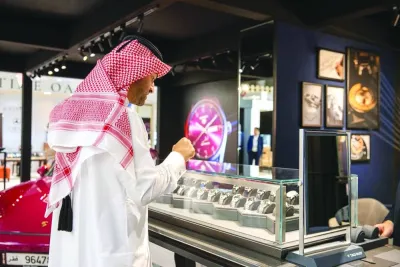The exhibition, held under the patronage of Qatar Museums’ (QM) Chairperson, HE Sheikha Al Mayassa bint Hamad bin Khalifa al-Thani, shows a new element of MIA’s extraordinary permanent collection by highlighting the connection between three major dynasties that marked the start of the early modern period in Islamic art – the Ottoman, Safavid, and Mughal empires.

Polychrome Cuerda Seca tile with floral and foliate motifs during the Mughal empire, Pakistan (Lahore) in the 17th century.

Black and turquoise-glazed hexagonal tiles with floral motifs during the Timurid or Safavid empire, Iran (Tabriz) in the 15th -16th century.
Due to popular demand, the exhibition has been extended to run until January 27, 2018. This is the last chance for visitors to discover the exchange of artistic and material cultures between three neighbouring empires, primarily from the 15th to the 19th centuries.
The exhibition also illustrates the cultural and artistic background of this time by featuring artefacts including carpets, manuscripts, metalwork and ceramics.
Demonstrating the vast cultural contributions of the Ottoman, Safavid, and Mughal empires, another significant exhibition on show at MIA is the Powder and Damask: Islamic Arms and Armour from the Collection of Fadel al-Mansoori.
Al-Mansoori became the first Qatari collector to exhibit his private collection at MIA.
The exhibition, which is running until May 12, 2018, presents edged weapons and firearms crafted primarily in Turkey, Iran and India from the 17th to the mid-19th century. It captures al-Mansoori’s passion for arms and amour, which began seven years ago, and has since grown into one of the best examples of popular craftsmanship styles across the three empires.
Powder and Damask explores the art of craftsmanship, which reached unprecedented levels in these regions under the Ottoman, Safavid and Mughal empires, where weapons were valued not only for their intended purpose but as works of art as well.
The objects featured as part of the collection are great examples of the diverse styles and materials, such as ivory, horn, gold inlay and calligraphy, used to decorate weapons during this time period.
A range of educational programmes, workshops, activities and events continue to be organised alongside both exhibitions, which will inspire engagement and provide enriching opportunities for the people of Qatar.

Iznik tile, Turkey, Circa 1575.
The Museum of Islamic Arts’ (MIA) blockbuster exhibition, Imperial Threads: Motifs and Artisans from Turkey, Iran and India, hit a new record with more than 90,000 visitors enjoying the splendor of ancient craftsmanship since it opened.


